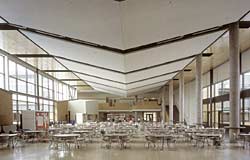Daylighting in Schools, Grades K-12
Modeling Daylight in Interior Spaces
Joel Loveland, director of the Seattle Daylighting Lab, oversees his group's consultations with architects and lighting designers to shape school designs for maximum daylighting capability. The consultants prioritize daylighting as a building design goal, while working with the budget and programmatic requirements. Some of the design principles of the Daylighting Lab are:
- Treat the building as a luminaire.
- Separate the vision and daylight glazings.
- Position the daylighting apertures to create mood and visual focus.
- Address the requirements of the visual task.
- Integrate the daylighting system with the architecture.
- Integrate the daylighting system with the other building systems.
The Daylighting Lab uses modeling to predict exact natural lighting levels so that electric lighting and controls can be specified to work with and complement the daylight.
|
||||||||||||||
Prototype Classroom
A high performance prototype classroom in Mt. Angel, Oregon, created through the combined efforts of many experts and design firms, including BOORA, SOLARC, Prof. Charlie Brown of the Seattle Daylighting Lab, and SRG Partnership seeks to light a classroom during daylight hours without any electric light, with minimum cost. Electric light was added for the infrequent occasions when the classroom was used at night, but the large skylight opening on the ceiling distributes light to the entire classroom. A rectangular suspended device dubbed "the halo" is made of translucent material that reflects part of the light onto the ceiling and walls, while letting part of the light into the room. The edges of the room receive two sources of light, from the reflection and the direct light. This prototype is designed for single story ground floor buildings in moderate climates but the model could be adapted into two story buildings with light shafts, and other region and climate types.
Clackamas High School, Portland, OR
BOORA, Portland, OR, has developed successive daylit schools grades K-12 including Ash Creek Intermediate School, Monmouth, OR and Clackamas High School, Portland, OR. Most buildings spend more on cooling than on heating, so daylighting principles in schools typically focus on bringing in light rather than heat. In the case of Clackamas High School (completed in 2002 for $127.71 /s.f.) control of daylight was accomplished using light shelves and shading devices. Light bounces off the top of the light shelf into the ceiling of the first floor spaces. The overhang shades the window below it. This allows a higher visible transmittance glazing in the daylight aperture if it is out of normal sight lines. Since the ceiling is the most important light-reflecting surface, using this surface to bounce daylight deep into the room can be highly effective. Both of these strategies are utilized in light shelf designs. Rooms in this facility use occupancy sensors, timers and daylight sensors to control output of electric light. Two rows of suspended T-5 fixtures running parallel to exterior windows are used for supplemental lighting, with the inner row on dimming ballasts. Ceilings are shaped to reflect light more evenly throughout rooms. The cafeteria uses virtually no electric light yet offers a variety of light and dark options for students through means of mechanized window shades. (Figure 4.) Heinz Rudolph, FAIA, principal of BOORA, states, "When everything is said and done a building needs a mixture of daylight and electic light, and good control devices."
|











